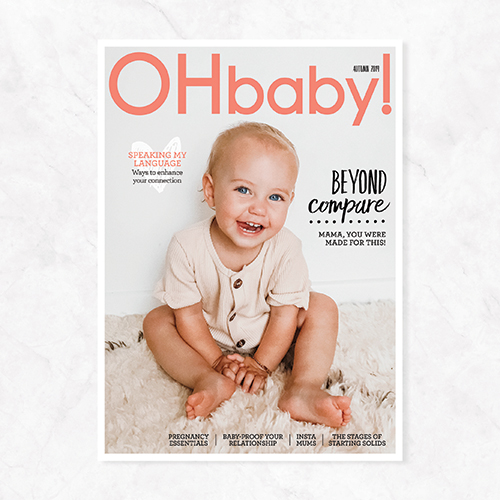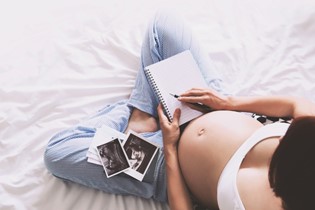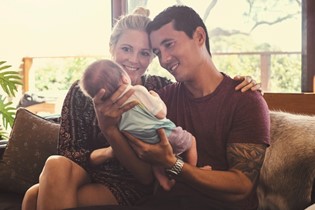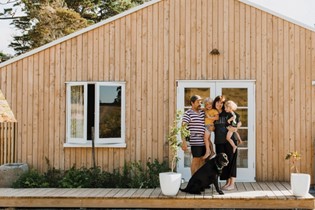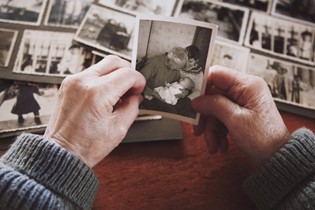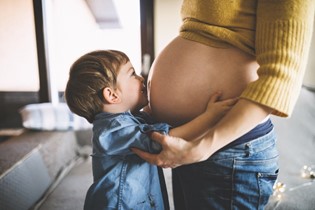Nutritionist tips for serving up solids

Introducing your baby to solid food is a significant – but daunting – milestone. Nutritionist Hannah Gentile is here to help you serve up solids with confidence.
Starting solids is often a much-debated topic. Questions abound! What age to start, whether to use purées or go straight to finger foods, what to avoid, and what to serve. As a nutritionist and a mum to two kids, I have seen vastly different ‘starting solids’ journeys over the last 10 years. The one thing I can tell you without hesitation – there is no single ‘right way’. What I have seen, however, is a distinct path that most children will take in their journey. This article describes that path, so that you can recognise the signs in your child and make the best decisions based on their needs.
Most children will start their solid foods journey at around the six-month mark. The best advice I can give is to listen to your baby. Parents often read hundreds of books and blogs before their child is born and have a plan mapped out of when their baby will start solids and what their first foods will be. It is good to be informed, and it’s great to be clear on what you want for your baby. However, when it comes down to it, you need to do what is right for your baby. My daughter was not interested in solid foods until she was six months old. She choked on finger foods, and spent a lot longer than I’d anticipated exploring her purées. My son was all about finger foods at five-and-a-half months old. Every child has different needs. Listen to what your child is telling you. This is not about your plan, it’s about their plan.
TASTE AND SEE
Now we’ll look at the general stages of development a child will go through in their readiness for solid food. Some families choose to follow a finger-food schedule from early on. I don’t refer to this as baby-led weaning, as you can actually do baby-led weaning with purees. I encourage families to have purées in their child’s diet to allow for a diversity of textures. Baby-led weaning, if truly related to the science, is about listening to your child’s feeding cues.

Regardless of when or how you start, the vast majority of babies will be comfortable starting with a few tastes of a puréed vegetable. This is generally referred to as Phase One and can continue up to seven or eight months old. I like to call this the Experimentation Phase. Lots of different flavours are all the go for this age group. Here are some handy ways to know if your child is at this stage:
☙ He or she prefers food to be puréed, mashed or slightly lumpy.
☙ Milk is still the primary nutrient and given prior to solids.
☙ He or she is really only interested in two, working up to three, small meals per day.
ONE LUMP OR TWO
Phase Two starts around seven to eight months old and typically continues to around nine or ten months old. I’ve termed this the Texture Phase. You should continue providing a variety of flavours, but now you want to start thinking about the different ways you can add texture. By seven-and-a-half months, most babies will be okay with puréed, mashed and slightly lumpy foods.
Now is the time to add some more lumps. Purée your baby’s foods less (just pulse a couple of times in the blender). You can even offer a few soft fruits for your baby to suck on. If you are nervous about giving your baby whole fruit, you can always use a silicon mesh teether. Some easy soft fruits that your baby may like to try include watermelon, banana, kiwifruit, mango and stewed apple. You will recognise the texture phase because:
☙ Your baby will start to be more interested in food than milk. Some mealtimes may now start with food rather than milk – although this is entirely up to you.
☙ There is less or no gagging occurring and your baby’s appetite is increasing.
|
HELP YOURSELF
|
HOLD UP
Phase Two typically ends abruptly with a common occurrence referred to as spoon refusal. This often happens when babies are around nine to ten months old. Infants typically turn their head away, try to grab at, or push away the spoon.
There are several reasons for this happening. Some babies, my youngest included, just like grabbing at things. An easy tip for counteracting this is to give your baby his own spoon – you can even load it with some food, while you continue to feed him from your spoon. Sometimes I would even swap spoons, loading one and giving it to my little boy, then switching it with the other loaded spoon when he was done.
Spoon refusal may also be an indicator that your baby is ready for Phase Three of starting solids, or what I call the Independence Phase. In this stage we want our little ones to have ample access to finger foods, which they can pick up and eat all by themselves.
Babies around this age start to gain more independence. Many children are starting to crawl, some may be standing or even taking their first steps! They are great explorers, carving their own journey in the world – or at least around the house. Their meal times are no different. As they start to understand that they are separate individuals, they also begin to realise they can control and play a role in their own lives. Obviously this is not as well thought-out as the temper tantrum of the ‘terrible twos’, or the bossy rule-driven behaviour of five-year-olds – but our babies are starting to progress into toddlerhood and have a new level of independence to show for it.
Part of this newfound independence is the ‘I can feed myself’ mentality. By Phase Three, babies just love the idea of touching and playing with their own food. It is normal for them to screw their face up at a new food. This is a reaction we all have to something unfamiliar. Remember it can take 10 to 15 tastes for a baby to become familiar with and accepting of a new food.
You will recognise Phase Three because:
☙ Baby may start to refuse to spoon-feed and prefer to self-feed.
☙ Baby has learnt to grind and suck food until it is swallowable.
☙ Baby is preferring solid foods when waking. Milk is being fed prior to bed or from a sippy cup, rather than upon waking.

|
HERE TO HELP 1. Highchair. I prefer the ones which attach to the table, as they make baby part of the family action, are easier to clean, and are transportable for restaurants or vacations. 2. A Ninja or other small handheld stick blender. These are brilliant for whipping up homemade baby food. 3. Silicone bibs with a lip. The ‘drop zone’ prevents food falling straight to the floor. Plus, these can be washed with the dishes. Worth their weight in gold. 4. Silicone mesh feeder. Super handy for little ones learning to feed themselves. These clever products are convenient, keep the mess semi-contained and are a safer option for independent feeding. 5. Suction bowl or mat. These help keep the food on the table or highchair – to a certain extent! 6. Spill mat. This is not an absolute necessity, but it is a very useful ‘nice-to-have’. I’d definitely be making the investment if your dining room is carpeted. Anything which makes it possible to pick up all the debris and tip it out in one easy go, without the need for sweeping, vacuum cleaning or mopping every time baby eats, is worth the money in my book! The other option is to get a dog – however, the mat is a much cheaper, low-maintenance option. |
|
THE GOLDEN RULES 1. Always watch your baby whilst they’re eating. Choking is quick and silent. 2. Never give a child food in the car. Other than turning your car into a beach of crumbs, it is also a very dangerous thing to do. As with rule one – choking is quick and silent. When you have a child harnessed into his seat, it is a very long process to pull over, unbuckle him, and start dealing with a choking incident – that is if you even notice him choking in the first place. 3. Brush up on CPR. It is always worthwhile doing this when you have a child anyhow. There are many half-day courses around aimed at parents with young babies, so enrol and get along to one of those – even before baby is born, if possible. 4. Avoid salty, sticky or sweet foods. These are unnecessary in the first years. |
Hannah Gentile is a registered nutritionist and mother of two. She provides nutritional support and advice for conception, pregnancy, starting solids and fussy eating. Find her at nourishedbynature.co.nz.

AS FEATURED IN ISSUE 45 OF OHbaby! MAGAZINE. CHECK OUT OTHER ARTICLES IN THIS ISSUE BELOW
